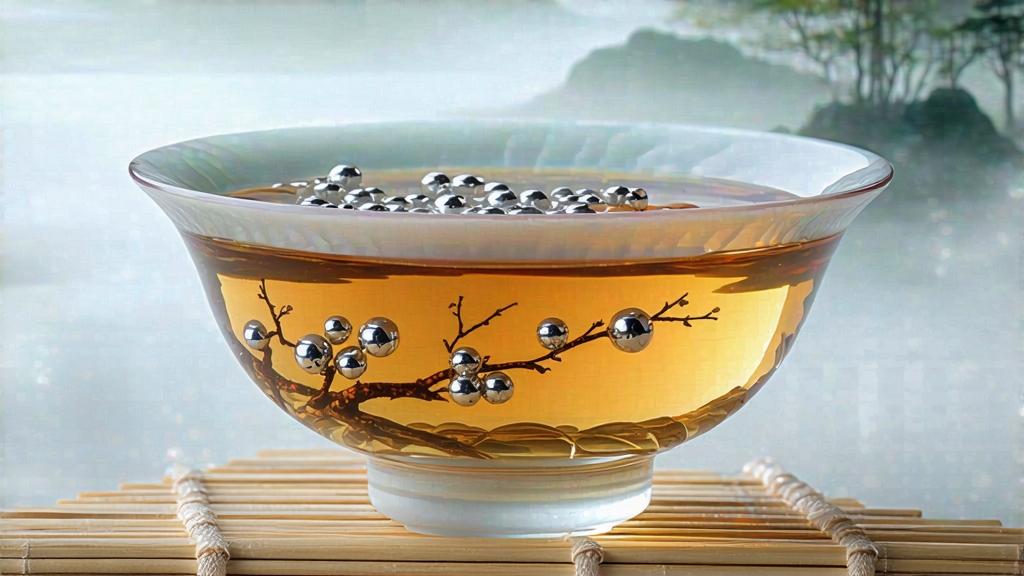
Among the six great families of Chinese tea, white tea is the least assertive yet the most enduring, a style whose elegance is measured by what it refuses to do: no rolling, no roasting, no heavy firing. Within this minimalist lineage, Bai Hao Yin Zhen—“Silver Needle” or simply “White Down”—stands as the apex, the first picking, the purest expression of leaf, air, and time. International drinkers often meet white tea through bagged blends labeled “silver tips,” but the original, single-origin Yin Zhen from northern Fujian is a different creature entirely: a tea that can taste like chilled rainwater collected in a marble basin, or like warm almond milk sipped under pear blossoms, depending on the year, the field, and the wrist-watch precision of its withering.
Historical whispers
Song dynasty scrolls already praise “white cakes” pressed from large-leaf tea growing along the Min River, yet the name Yin Zhen does not appear in court records until the late Ming. Local legend attributes its birth to a 1796 epidemic in Fuding county; villagers, forbidden to fire their kilns lest sparks spread disease, simply air-dried the earliest spring buds on reed trays. The resulting liquor was pale, sweet, and reputedly cooling to feverish blood. By the Guangxu reign (1875-1908) the tea had become a tribute item, carried in silk-lined boxes along the same courier roads that took Fujian’s Shi Ru clay to the imperial kilns at Jingdezhen. European merchants first recorded it in 1891 as “Flowery Pekoe Silver Tips,” priced higher than first-flush Darjeeling on the London auction floor. Thus a tea invented by accident entered global consciousness as a luxury commodity, even while its makers continued to think of it as village medicine.
Micro-terroir: two counties, one mountain spine
Authentic Bai Hao Yin Zhen is picked only in spring, only from two cultivars—Fuding Da Bai and Zhenghe Da Bai—each evolved from Camellia sinensis var. sinensis on the eastern slope of the Taimu mountain range. The Fuding side faces the East China Sea; maritime fog drifts inland at dawn, coating the buds in a salt-tinged film that slows photosynthesis and concentrates amino acids. Zhenghe, slightly higher and more continental, gives needles that are marginally sturdier, with a quieter fragrance but deeper throat resonance. Purists debate which county produces the “true” Yin Zhen much as Burgundy lovers quarrel over Chambolle versus Gevrey; in practice, the best lots are often micro-blends, assembled by cuppers who marry the marine lift of Fuding with the bass note of Zhenghe.
Plucking ritual: one bud, no leaf, no compromise
The picking window opens when the first silver down becomes visible on the tip of the bud, usually between March 15 and April 10, and closes within 48 hours once the bud begins to unfurl. Experienced pluckers use only the thumb and index finger, snapping the stem with a click that signals the perfect break; nails must be trimmed to avoid bruising. A full kilogram of finished tea requires roughly 30,000 buds, all picked before ten o’clock in the morning while dew still glints like powdered glass. Because mechanical harvesters cannot discriminate downy tips from coarser leaves, every Yin Zhen on earth is still hand-plucked, making it one of the last teas whose production scales directly with human labour rather than engineering.
Withering: the invisible craft
Once in the factory, the buds are laid no thicker than one finger-width on bamboo trays stacked like sliding drawers in a high-ceilinged loft. Here the master’s skill lies in doing almost nothing: adjusting louvered windows to coax a breeze, shifting trays if the sun grows too assertive, reading the moisture in the air with the same instinct a vintner uses to judge malolactic timing. Over 48-72 hours the buds lose about 70 % of their water, cell walls relax, and enzymatic oxidation proceeds at a glacial pace. Unlike green tea, whose character is fixed by a quick kill-green, Yin Zhen exists in a twilight zone where oxidation is neither encouraged nor abruptly halted; the result is a liquor that carries the freshness of an unfermented tea yet the rounded corners of a lightly oxidised one. When the bud can be folded in half without snapping, and the down turns from bright silver to a muted pew